






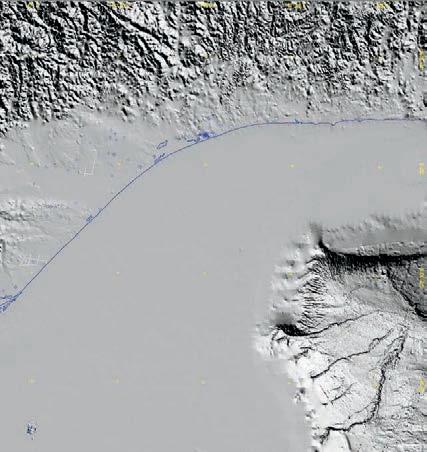







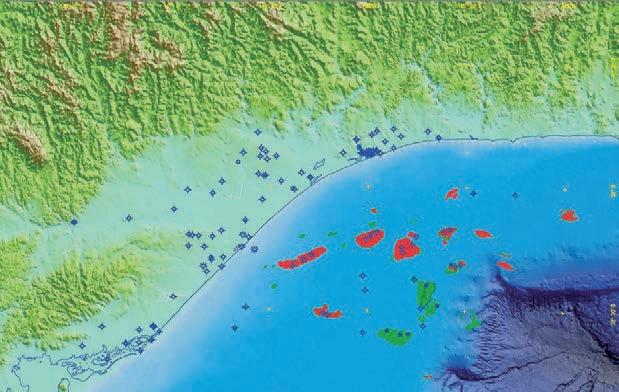


Seamlessly bring more data into the fold. Dynamically present your insight like never before.

The Petrosys Plug-in for Petrel ® gives you access to powerful Petrosys mapping, surface modeling and data exchange from right where you need it – inside Petrel. Now you have the power to effortlessly and meticulously bring your critical knowledge together on one potent mapping canvas. Work intuitively with your Petrel knowledge and, should you so require, simultaneously aggregate, map and model data direct from multiple other sources – OpenWorks ®, ArcSDE®, IHS ™ Kingdom ®, PPDM ™ and more. Refine, enhance and then present your results in beautiful, compelling detail. The result? Decision-making is accelerated through consistent mapping and surface modeling as focus moves from regional overview through to the field and reservoir scale. To learn more go to www.petrosys.com.au/petrel
CSPG OFFICE
#110, 333 – 5th Avenue SW Calgary, Alberta, Canada T2P 3B6
Tel: 403-264-5610
Web: www.cspg.org
Office hours: Monday to Friday, 8:30am to 4:00pm
Executive Director: Lis Bjeld
Tel: 403-513-1235, Email: lis.bjeld@cspg.org
Event Coordinator: Kelsey Thompson
Tel: 403-513-1226, Email: kelsey.thompson@cspg.org
Member Services:
Tel: 403-264-5610, Email: membership@cspg.org
Publications and Website: Emma MacPherson
Email: emma.macpherson@cspg.org, Tel: 403-513-1230
Educational Trust Fund/Outreach Coordinator: Kasandra Amaro
Tel: 403-513-1226, Email: kasandra.amaro@cspg.org
Technical Programs: Biljana Popovic
Tel: 403-513-1225, Email: biljana.popovic@cspg.org
Corporate Sponsorship: Lis Bjeld
Tel: 403-513-1235, Email: lis.bjeld@cspg.org
Controller: Eric Tang
Tel: 403-513-1232, Email: eric.tang@cspg.org
EDITORS/AUTHORS
Please submit RESERVOIR articles to the CSPG office. Submission deadline is the 23rd day of the month, two months prior to issue date. (e.g., January 23 for the March issue).
To publish an article, the CSPG requires digital copies of the document. Text should be in Microsoft Word format and illustrations should be in TIFF format at 300 dpi., at final size. For additional information on manuscript preparation, refer to the Guidelines for Authors published in the CSPG Bulletin or contact the editor.
Technical Editors
Hugh S. Mosher Colin Yeo (Assistant Tech. Editor) Nunaga Resources Ltd. Encana Corporation M.: 403-809-9997 Tel: 403-645-7724
Email: hsmosher@telus.net Email: colin.yeo@encana.com
Coordinating Editor
Emma MacPherson, Publications Coordinator, CSPG Tel: 403-513-1230, emma.macpherson@cspg.org,
ADVERTISING
Advertising inquiries should be directed to Emma MacPherson, Tel: 403-513-1230 email: emma.macpherson@cspg.org. The deadline to reserve advertising space is the 23rd day of the month, two months prior to issue date.
The RESERVOIR is published 11 times per year by the Canadian Society of Petroleum Geologists. This includes a combined issue for the months of July and August. The purpose of the RESERVOIR is to publicize the Society’s many activities and to promote the geosciences. We look for both technical and non-technical material to publish. Additional information on the RESERVOIR’s submission guidelines can be found
office. No official endorsement or sponsorship by the CSPG is implied for any advertisement, insert, or article that appears in the Reservoir unless otherwise noted. All submitted materials are reviewed by the editor. We reserve the right to edit all submissions, including letters to the Editor. Submissions must include your name, address, and membership number (if applicable). The material contained in this publication is intended for informational use only.
While reasonable care has been taken, authors and the CSPG make no guarantees that any of the equations, schematics, or devices discussed will perform as expected or that they will give the desired results. Some information contained herein may be inaccurate or may vary from standard measurements.
The CSPG expressly disclaims any and all liability for the acts, omissions, or conduct of any third-party user of information contained in this publication. Under no circumstances shall the CSPG and its officers, directors, employees, and agents be liable for any injury, loss, damage, or expense arising in any manner whatsoever from the acts, omissions, or conduct of any third-party user. Designed and Printed by The Data Group of Companies, Calgary, Alberta.
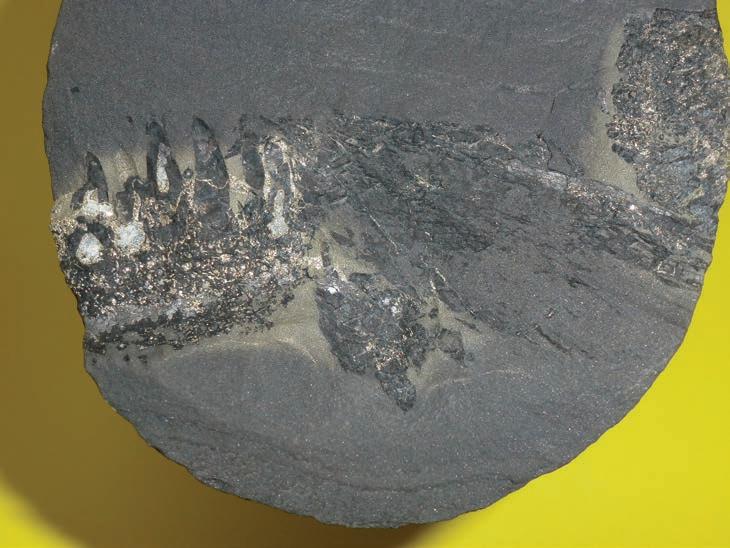
FRONT COVER
Ichthyosaur jaw fragment discovered in 2011 at a depth of about 3.7 km in a core from the Lower Triassic Montney Formation , north-east British Columbia. Core diameter is 66 mm. Palaeontological studies currently being conducted on this fossil will shed further light on Triassic marine reptiles. Post-research, the specimen will be deposited at the Royal B.C. Museum. Photo by Jim Wood.

Outcrops, Stratigraphy, and Geomodeling: Lisa Stright, University of Utah,USA Michael Pyrcz, Chevron,USA
Multi-scale Data and Multi-variate Modeling:
Sanjay Srinivasan, University of Texas at Austin, USA
Claude Scheepens, ConocoPhillips, USA
Properties in Models: Advancing Continuous Variables
Mohan Srivastava, FSS Consultants, Canada
Colin Daly, Schlumberger, UK
Post-processing Geomodels: Clayton Deutsch, University of Alberta, Canada Weishan Ren, Statoil, Canada
Modeling Uncertainty:
Emmanuel Gringarten, Paradigm, USA
W. Scott Meddaugh, Midwestern State University, USA
Geomodeling Unconventionals: Jeffrey Yarus, Halliburton, USA
Ian Gates, University of Calgary, Canada













PAST PRESIDENT
Paul MacKay • Shale Petroleum Ltd. paul.mackay@shalepetroleum.com Tel: 403.457.3930
PRESIDENT Dale Leckie
PRESIDENT ELECT
Tony Cadrin • Journey Energy Inc. tony.cadrin@journeyenergy.ca Tel: 403.303.3493
FINANCE DIRECTOR
Gord Stabb • Durando Resources Corp. gstabb@durando.ca Tel: 403.819.8778
FINANCE DIRECTOR ELECT
Astrid Arts • Cenovus Energy aarts@barrick-energy.com Tel: 403.766.5862
DIRECTOR
Alexis Anastas • Nexen Energy ULC alexis_anastas@nexencnoocltd.com Tel: 403.699.4965
DIRECTOR
Andrew Fox • MEG Energy Corp. andrew.fox@megenergy.com Tel: 403.770.5345
DIRECTOR
Milovan Fustic • Statoil Canada Ltd. MFUS@statoil.com Tel: 403.724.3307
DIRECTOR
Michael Laberge • Channel Energy Inc. mike.laberge@telus.net Tel: 403.301.3739
DIRECTOR
Robert Mummery • Almandine Resources Inc. mummery1@telus.net Tel: 403.651.4917
DIRECTOR
Weishan Ren • Statoil Canada Ltd. wren@statoil.com Tel: 403.724.0325
DIRECTOR
Darren Roblin • Endurance Energy snowice@telus.net Tel: 587.233.0784
EXECUTIVE DIRECTOR
Lis Bjeld • CSPG lis.bjeld@cspg.org Tel: 403.513.1235
A message from Darren Roblin, Director Corporate Relations

Companies in the Canadian energy industry depend on the geoscience community to be knowledgeable and innovative and to find, quantify and optimize oil and gas and manage risk in exploration, development and operations. The CSPG’s Corporate Partners realize that Geoscientists who are CSPG members are strengthened through participation in the geoscience community as part of the CSPG’s mission is to advance the scientific technical learning and professional development of Geoscientists. Furthermore, Corporate Partners realize that such advancements are essential to the medium and long term achievement of corporate goals. As such, the strength of the Canadian geoscience community, the CSPG, and its members is integral to the continuing strength of the Canadian energy industry.
The CSPG offers a home for the geoscience community where members of all vintages and specializations benefit from sharing scientific and technical concepts, being exposed to new play ideas and case studies and sourcing quality professional development. Examples of the sharing of technical concepts can be found at the highly successful “Division Talks”, sponsored by Cenovus Energy and many other division specific sponsors, where Geoscientists can attend regular talks by division groups including: basin analysis, core and samples, environment, geomodeling, heavy oil and oil sands, international, palaeontology, sedimentology and structural geology. Individual contribution and participation in the community enhances both the community and the individual member’s experience in a mutually beneficial way. The member volunteers that lead and support the CSPG’s many activities make considerable contributions to both the geoscience community and the technical proficiency of the society.
As an organisation, the CSPG largely focuses on services to its members and provides technical knowledge, often with the support of sponsors. This technical knowledge is delivered in many forms including on line and physical publications, technical luncheons, conferences (both independently and in conjunction with other societies) and training in the classroom and in the field. GeoLOGIC Systems sponsors the webcasting of the Technical Luncheons in case you can’t make the luncheon or did but cannot remember key information at a later date. More examples of technical information the CSPG delivers to the membership include: the upcoming Gussow Conference with the theme Advances in Applied Geomodeling for Hydrocarbon Reservoirs; or the recent Reservoir publication entitled Geomechanics For Everyone, Part 3: What is Fracability? Understanding the Effects of Geomechanical and Structural Factors on Fracturing in Unconventional Reservoirs written by Vahid Mostafavi and Keri Yule; or the standby 36 volumes of the Geological Atlas of the Western Canada Sedimentary Basin available digitally on the CSPG website thanks in part to Devon Canada. The CSPG also works with students in an outreach program, provides scholarships and runs the Student industry Field Trip (SIFT) with the support of numerous generous sponsors. The CSPG Educational Trust Fund (ETF) is a registered charity that supports programs that advance energy geoscience education and promote public education about the energy geosciences.
As a home for the Geoscience community, the CSPG provides many networking events. Sports events include the Classic Golf Tournament, Mixed Golf Tournament, CSPG Road Race and Fun Run and CSPG Squash Tournament. Recently, this year’s Energy Drivers Event was a great success where influential people in our industry
(Continued on page 7...)


Each year the CSPG awards the Medal of Merit to authors of the best peer-reviewed paper published during the previous year on a subject related to the petroleum geology of Canada. A sterling silver medal is presented to each of the authors. The list of previous winners can be seen under awards on the CSPG website.
The Medal of Merit Committee searches the literature for potential candidates and selects the best paper, favouring well written and illustrated papers with novel ideas that have relevance to Canadian petroleum geology and/or the broader practice of petroleum geology. The committee will be evaluating papers published during the calendar year 2013 for the 2014 award. In addition to papers from academic journals, papers which form part of a special publication are also eligible. If you know of a 2013 peer-reviewed paper that the committee should consider, please submit the details by July 31, 2014 to:
SAMARIUM
geoLOGIC systems ltd.
TITANIUM
ConocoPhillips
APEGA
Nexen ULC
IHS
Shell Canada Limited
PLATINUM
Schlumberger Canada Limited
Cenovus Energy Inc.
Imperial Oil Resources
AGAT Laboratories
GOLD
Devon Canada Corporation
MEG Energy Corp.
Tourmaline
Baker Hughes
SILVER
CGG Services (Canada) Inc.
Suncor Energy
MJ Systems
Encana Corporation
Canadian Natural Resources Ltd.
Athabasca Oil Corporation
Enerplus
EOG Resources Canada Inc.
Husky
ION Geophysical
Petrosys
BRONZE
Olympic Seismic Ltd.
Arcis Seismic Solutions
Seisware
Loring Tarcore
PGS
Saudi Aramco
Roke Technologies Ltd.
Belloy Petroleum Consulting
Earth Signal Processing Ltd
Sensor Geophysical Ltd.
Tucker Energy Services Canada
Pro Geo Consultants
Talisman Energy
Geovariances
Hunt Oil
Tesla
TGS
Continental Laboratories (1985) Ltd.
Total Gas Detection Ltd.
RPS Energy Canada Ltd.
Explor
GLJ Petroleum Consultants Ltd.
Paradigm Geophysical (Canada) Corp.
PLS Inc
As of May 2014
A Special Thanks to Geologic Systems Ltd., CSPG ’s Top Sponsor of the Month.
(...Continued from page 5)
mixed with CSPG members. In addition, informal Geocafé sessions are held in the CSPG offices. All of these events are great networking opportunities for energy Geoscientists.
Clearly, the CSPG’s Corporate Partners and the Canadian energy industry in general benefit directly and indirectly through the strength of the geoscience community and the member Geoscientists. If you have not done so recently, you may want to take some time to review what is happening on the CSPG site at cspg.org.
New this year in the CSPG is the formalization of a Corporate Relations Committee. The mandate of the CSPG Corporate Relations Committee is to strengthen our relationship with energy industry companies in Canada by understanding the Geoscience needs of our Corporate Partners, raising their awareness of CSPG activities, helping develop and guide sponsorship interest and speaking to the advantages of membership for our Corporate Partners’ Geoscientists.
(Continued on page 30...)

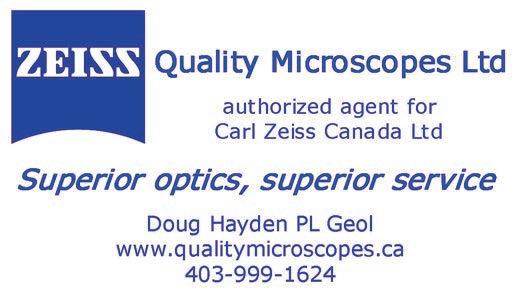






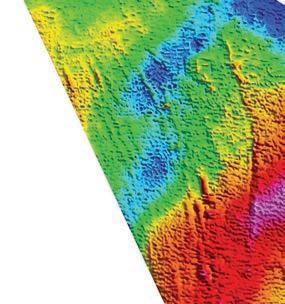


SPEAKER
Janok P. Bhattacharya McMaster University
11:30 am Tuesday, June 3rd, 2014 Calgary, TELUS Convention Centre Macleod Hall C/D Calgary, Alberta
Please note: The cut-off date for ticket sales is 1:00 pm, three business days before event. [Thursday, May 29, 2013].
CSPG Member Ticket Price: $45.00 + GST. Non-Member Ticket Price: $47.50 + GST.
Each CSPG Technical Luncheon is 1 APEGA PDH credit. Tickets may be purchased online at https://www.cspg.org/eSeries/ source/Events/index.cfm.
ABSTRACT
A common observation in many ancient clastic wedges is that shoreline deposits are commonly significantly finer than associated fluvial deposits. Abrupt downstream fining in rivers, and increase in tidal or marine influence, may mark the backwater and bayline limits, which are controlled primarily by slope, tidal range, and river discharge. The backwater distance, from the shoreline, is defined as the ratio of river depth versus slope, whereas the bayline is the tidal range divided by the slope. In Modern continental-scale low slope river systems (i.e. Slope < 0.0001),
such as the Mississippi and Amazon, backwaters may reach many hundreds of kilometers upstream, whereas they may be on the order of a few kilometers in steeper gradient systems.
Ancient deltaic systems of the Cretaceous interior seaway of North America, including the micro-tidal Turonian Ferron Sandstone Member in Utah, show coarse-grained pebblysandstone bedload river deposits that feed medium-to fine-grained sandy shorelines. Cross-sections allow estimates of channel depth and width, which can used to calculate the crosssectional area of a channel. Grain size and bedforms can be used to estimate flow velocity. When multiplied by the channel area, the velocity can be used to estimate discharge. Ferron trunk channels are on the order of 5-9 m deep with discharge (Q w) of less than about 1500 m 3 /s. This suggests moderate size upstream drainage basins and a propensity for downstream, distributary channels to produce hyperpycnal deltaic deposits.
Within the Ferron clastic wedge, the pebble-to sand transition lies several kilometers from co-eval shoreline deposits, suggesting a short backwater length. Slope estimates can also be made based on onlap distances of associated coastal prisms, as expressed in stratigraphic cross sections. For the Ferron, slopes > 0.001, are an orderof-magnitude steeper than for the lowgradient continental scale systems, like the Mississippi. This explains the position of the transition from pebbleto sand in the fluvial systems, at a few versus hundreds of kilometers from the shoreline, as well as the lack of pebbles in co-eval shorelines. Onlap limits of bay and lagoon deposits, of several tens of kilometers, mark the bayline and suggest an average tidal range of < 2m.
The Cenomanian Dunvegan Formation, in Alberta, contains trunk streams on the order of 10-28 m deep. Discharge estimates are correspondingly about 3 times larger that the Ferron sandstone. Brackish water indicators have been

found several tens of kilometers inland, suggesting the bayline was about 30km from the shoreline. Previous estimates of Dunvegan valley slopes are on the order of 0.0004, higher than the Mississippi, but lower than the Ferron. The gravelsand transition lies considerably farther landward as well, suggesting backwater distances might have been on the order of 100 km.
Estimation of slope and discharge thus can be made in ancient clastic systems and allow prediction of the partitioning of coarse versus fine-grained facies at choke-points, as defined by the backwater and bayline limits.
SPEAKER
Les Dabek, P.Geol. Geomodeling Technology Corp.
12:00 Noon
Wednesday, June 25th, 2014 Place: TBA Calgary, Alberta
Conventional reservoir characterization workflows suggest that reservoir permeability correlates most closely to shale volume (VShale). However, the effect of geological complexity involved in oil sand reservoirs, as well as the facies dependency of permeability and VShale is not well understood. This uncertainty is particularly significant in facies with permeability < 500 millidarcy. We integrated multi-scale exploration data from a producing McMurray Formation reservoir to demonstrate the impact of centimeter-scale reservoir architecture on permeability. The study uses highresolution 3D models of the near-wellbore region to characterize observed variability in percentage, orientation and dimension of mud laminae, breccia clasts and trace fossils.
We approached the problem from a geological perspective, creating models that are based on the geological relationships observed in cores or field analogues. Using process-oriented modeling, realistic small scale sedimentary structures and their volumes are achieved. Analytical reservoir properties derived from core plugs were distributed on the basis of geological relationships in these 3D models, at a scale

Sponsored by
below the resolution of wireline logs. As a result, flow-based numerical upscaling of these models generates permeability and porosity values capturing the effects of heterogeneity at the lamina scale.
We have established a set of correlations between permeability and shale volume by applying geology-driven 3D near-wellbore models. These models assume the facies are a result of variation in volume, bedding structure, and bioturbation of sand and mud. The absolute permeability varied within a tight range in each of these end member facies. These correlations fill the gap between the core plug scale, where the absolute permeability of each end member can be accurately measured, and the reservoir scale permeability. These fine near-wellbore models provide a tool for proper averaging of the core data within a target scale. The study indicated that the correlations between permeability and shale volume are facies dependent. Two major correlations were identified which were a result of the variations in bedding and biological structures. The sensitivity study that was performed indicated that the vertical permeability is more sensitive to the continuity and volume of the shale than the absolute permeability of each end members; nevertheless, for a given percentage of volume shale, the absolute permeability of mud has a greater impact on the average permeability than the absolute permeability of sand.
Les Dabek (P.Geol) graduated from Brandon University (Manitoba, Canada) in 1996 with a Bachelor of Science Degree in Geology. Les has worked for more than 12 years as geologist at Geomodeling Technology Corp, with 8 years as product manager for SBED and ReservoirStudio 3D earth modeling software. His recent work is providing SBED 3D permeability modeling services for petroleum-development of oil sands SAGD thermal projects.
There is no charge for the division talk and we welcome non-members of the CSPG. Please bring your lunch. For details or to present a geomodeling talk in the future, please contact Weishan Ren at (403) 724-0325, e-mail: wren@statoil.com.

Crossplotting of the upscale results improved the predictability of permeability with increased VShale and breccia percentages, and vertical permeability between two facies end members.

5.6 trillion barrels of bitumen and heavy-oil resource are estimated to occur globally in more than 100 countries, with most of that resource occurring in the western hemisphere (Hein et al., 2013). For Canada, this is a massive resource which faces considerable challenges. The challenges range from subsurface characterization to drilling and completion designs to project economics, as well as environmental and water considerations. In the past decade, significant advances in the development and production of these resources have occurred by way of the critical integration of geology, geophysics, engineering, modeling economics, and transportation. To continue with this theme of critical integration, the Canadian Society of Petroleum Geologists and the American Association of Petroleum Geologists will host a joint, multidisciplinary technical symposium on oil sands and heavy-oil. This symposium “Oil Sands and HeavyOil Symposium: A Local to Global Multidisciplinary Collaboration” will be held in Calgary at the Metropolitan Centre, October 14-16, 2014.
The goals of the symposium are to highlight the global nature of the resource, advances in recovery technologies, the contributions resource geoscientists are making to the challenges of environmental protection and social license, as well as driving prosperity and better standards of living for all through sustainable energy development.
This multidisciplinary technical symposium will take a holistic approach to the various
multifaceted aspects of the oil sands and heavy oil resources. Sessions will focus on geology, geophysics, engineering, environment, and regulatory aspects. The 6 half day sessions will cover the following topics:
• The international resource base: oil sand, heavy oil and bitumen occurrences and prospects around the world.
• The Elephants in the Room: Largescale geology characterization, including regional studies covering geology, geophysics, outcrop, core work, and geo-modeling.
• Eating the Elephants: Medium to micro-scale within-reservoir geology characterization, including detailed studies of compartmentalization, bitumen and reservoir fluids, fluid segregation within reservoirs, geo-modeling, and petrophysics.
• 21st Century Geology for Production: New drilling, completion and production technologies, conformance issues related to steam chambers for in-situ development; maximum operating pressures and other issues related to surface mining.
• Focus Session on Public Safety and In-Situ Recovery: Caprock definitions, description, integrity assessment, identification of faults and fractures, casing integrity and other factors that affect caprock integrity, its prediction,
maximum operating pressures and steam-chamber containment.
• Striking the Balance: Geoscience for better integrated resource management in a changing social and political climate.
This oil sands and heavy oil symposium will follow a three day single track format including core/poster sessions. A meeting of this scope and format will provide an intimate environment that is free of competing session content. The symposium will also provide those in attendance with the opportunity to interact with presenters and there will be dedicated time for group discussion.
Registration for the symposium is open and the rate for CSPG and AAPG members is $800 + gst and for non-members it is $950.00 + gst. Also, there are numerous sponsorship opportunities to support this event. More details and updates about this symposium can be found at www.cspg.org/ conferences.
Hein, Frances J., Dale A. Leckie, Steve Larter, and John R. Suter, 2013, Heavy oil and bitumen petroleum systems in Alberta and beyond: The future is nonconventional and the future is now, in F. J. Hein, D. A. Leckie, S. Larter, and J. R. Suter, eds., Heavy-oil and oil-sand petroleum systems in Alberta and beyond: AAPG Studies in Geology 64, p. 1-21.

Quantitative Log
14 – 16 Apr 2014
Reservoirs: 17 Apr 2014
and Registration at: www.spec2000.net/00-coursedates.htm
and Multi-Media Narrated Self-Study Courses Also Available
Instructor: E. R. (Ross) Crain. P.Eng. 1-403-845-2527 ross@spec2000.net
The tournament would like to thank the following 2012 Sponsors:
Diamond Sponsors
Schlumberger of Canada geoLOGIC Systems
Little Rock Document Services
Emerald Sponsors
Weatherford Canada
Partnership
RECON Petrotechnologies Ltd.
RBC Dominion Securities
ProGeo Consultants
MJ Systems
AGAT Laboratories IHS
Platinum Sponsors
ZIPCASH
West Canadian
Paradigm Geophysical
ATB Financial
GLJ Petroleum Consultants
Gold Sponsors
Arcis Corporation
Canadian Discovery Ltd.
ConocoPhillips Canada
Continental Laboratories
Datalog Technology Inc.
Frank Pogubila
Greystone Resources Ltd.
Knowledge Energy Ltd.
Total Gas Detection Ltd.
Seismic Brokerage Services
Silver Sponsors
Cambria Business Services
Gabel Energy Inc.
Bronze Sponsors
Canadian Stratigraphic Services
Fekete Associates
Sponsorship
Halliburton Group Canada
GeoStrata Resources Inc.
Energy Navigator
Divestco Inc.
Baker Hughes
Belloy Petroleum Consulting
Belgo Brasserie
LXL Consulting
Pason Systems Corp.
McLeay Geological Consulting
National Oilwell Varco
Painted Pony Petroleum Corp.
Pajak Engineering Ltd.
Rigsat Communications
Rockwell Consulting
Sample Pro Ltd.
Sproule Associates Ltd.
Typhoon Energy Ltd.
Global Energy Services
Martin Quinn
Hydro-Fax Resources Ltd.
San Dago Resources Ltd.
Register Online at cspg.org
Go to Events/ Sporting Events/ Classic Golf.
To complete registration login to the website with your CSPG member ID.
Please call (403) 513-1233 for assistance.
2 rounds of golf at Elbow Springs
Power Cart
Driving Range
Golf Shirt
Steak Dinner at Elbow Springs
Breakfast at Elbow Springs
Awards Banquet at The Petroleum Club (for you and your guest)
Draw Prizes
Daily Skill Prizes
Sponsorship Tents, prizes and gifts AND
Chance to win two separate draw prizes to any North American Destination
Tournament
*All prices include GST
*Discounts for students, first time players and previous players who refer a first time player.
Social events cancellation or additions require 72 hours notice before the event. Please contact Scott Thain (403) 262-9229, cell (403) 999– 8558 or email: cspgclassicgolf@gmail.com
Last day for refunds Friday June 13, 2014
This winter the University Outreach committee was able to send Dr. Brad Hayes to six schools in Western Canada. The schools hosting the talk were the University of Victoria, Vancouver Island University, Yukon College, University of British Columbia, Simon Fraser University and University of Alberta. Brad is the president of Petrel Robertson Consulting here in Calgary and a CSPG Past-President, serving his term in 2001.
The title of the talk was “Unconventional Oil and Gas Development: What Does it Mean for Future Geoscientists.” The talk began with a broad discussion about what makes plays “unconventional,” why they are important, where they are, and how they are explored for and developed. The discussion of the changing roles for geoscientists followed. With the importance of water intensive completion techniques like hydraulic fracturing in today’s oilpatch, much of this part of the talk centered on exploration for suitable water sources and water disposal zones, something Brad has experience with in the Horn River Basin and other areas. At Petrel Robertson Consulting, Brad noted that “in Canada we’re probably spending about half of our time mapping water in the subsurface for the petroleum industry.” This is an important thing to relay to students who may be thinking about what skills they might need, their next steps and what the themes of their careers might be.
The principal audience for the tour was the students, who got an inside look at the type of work that’s being done by geoscientists in Calgary – outside what they might think of as traditional roles of geologists and geophysicists. The students were also told about opportunities for students from the CSPG, including activity grants, scholarships and the Student Industry Field Trip (SIFT). For students at most of the schools on Brad’s tour which don’t have traditionally strong “soft-rock” programs, this was likely a unique opportunity to get a glimpse into the oil and gas industry and to get specifics on the wide range of opportunities. There was a lot of interest from faculty as well, and Brad was surprised to learn at UBC in particular how much faculty effort is going into mathematical modeling and engineering work on hydraulic fracturing.
It is understated to say unconventional resource development and hydraulic fracturing is a hot topic in Canada. So in addition to speaking for students, Brad was able to speak to wider community groups in both Nanaimo and Whitehorse while on tour and also made time for the Yukon News and CBC North in Whitehorse. For curious and concerned members of the broader public this was a chance to hear from a professional who is actively working on these issues here in Calgary. In the Yukon where unconventional development is still in the future, the government is
currently working on regulations to govern unconventional development. In his CBC interview he stressed the importance of having geoscientists gathering facts about the plays that might be developed and the water resources before the initiation of major development. In the article “Meet the Frackers” in the Yukon News, when asked about environmental concerns surrounding water and unconventional development, Brad said that “there are good regulations in place in other jurisdictions to manage how water is used in the industry” and that “the key is making sure the regulations are followed.”
The University Outreach Committee is grateful to Brad for giving his time to spread the word to students about how the industry they may inherit in their career will be different than what was known by the last generation. The committee is also glad that Brad got to add his voice to the public debate; a debate that is not short on voices though the voices of professional geoscientists who gather facts on the reservoirs and aquifers are often hard to find.
If you or anybody you know is interested in taking part in a University Lecture Tour, please contact Chad Glemser (C.Glemser@ shell.com) or Garrett Quinn (gquinn@ osumcorp.com).



Dr. Peter Putnam’s involvement in CSPG began in 1978, and he’s been a valuable contributor ever since. He has earned a Link Award (1984) and a Service Award (1997). He was a member of the Executive Committee (1983, 1992-1994), serving as President in 1993. He has worked on a large number of committees, including the President’s Award Committee Chair (1993), the National Liaison Committee (1994), Canadian Geoscience Council Liaison Member (1994-1995) and Educational Trust Fund Committee (19951996). He also served as Associate and Book Review Editor of the Bulletin (1984-1988).
Dr. Putnam graduated with First Class Honors from Brock University (1977), obtained his Master’s Degree from the University of Calgary (1979) and earned his Ph.D. from the University of Calgary (1985) with a thesis on Reservoir Origin and Controls on Hydrocarbon Distributions Interpreted with a Computerized Data Base, Lower Cretaceous Mannville Group, West-Central Saskatchewan.
His distinguished career has spanned 6 continents and more than 35 countries, working in in research, operations, corporate management, strategic positioning and equity raising. He started his career with Husky Oil Operations in 1979, quickly becoming
the Section Leader of the Saskatchewan Exploration and Development Group, Heavy Oil Division. He joined Petrel Robertson Consulting in 1985 and became president 2000, and is still Chairman of the Board. Since 2006, he has been president of Hay Valley Resources, while also serving as the Chairman of Central European Petroleum’s Board of Directors. Notably, Dr. Putnam’s work assisted the first junior company to enter Algeria (First Calgary), the conceptual basis and contribution to the exploration and development of the Grosmont carbonates in northern Alberta (Osum and Laricina) and instigating exploration in Eastern Germany post-reunification (CEP).
He has been very involved in the geoscience community: serving as an APEGA Councilor (2000-2003); at the University of Calgary as an Adjunct Professor (2000-2007) and a member of the Selection Committee for the Dean of Graduate Studies (2001); Committee Member and co-author of COGEH chapter on oil sands under the auspices of the Alberta Securities Commission (2005-2006); Member of the Committee advising the provincial and federal governments on the future of government geoscience in Alberta (1994-1995); and a Distinguished Lecturer Committee Member of the American Association of Petroleum Geologists.
Since 1980, Dr. Putnam has authored or coauthored numerous papers on a variety of topics dealing with various facets of applied geology including stratigraphy, sedimentology, formation pressures, reservoir composition, siliciclastics, carbonates, thermal recovery and, ground-penetrating radar applications. The geographical coverage of his publications includes Canada, the United States, Australia and Yemen. He has presented at a diverse range of locales including scientific conventions, specialized research and industry symposia, government agencies, universities, meetings of educators and financial meetings. He is frequently an invited speaker and distinguished lecturer, and has presented at seven CSPG monthly luncheons. Dr. Putnam has also presented several posters and core displays at CSPG and AAPG conferences
Over his career Dr. Putnam has been a technical specialist, an operational professional, an advisor, an executive, a board member and a company founder. His business acumen has enhanced the Canadian and international oil and gas industries and his volunteerism has been exemplary. He has had an illustrious geological and business career and the CSPG is proud to welcome Dr. Peter Putnam into the ranks of Honorary Members.




On your mark! Get ready, the CSPG, CSEG, & CAPL will be running our annual Roadrace and Fun Run this September.
Again, we are offering both a 10km and a 5km race. We have secured Winning Time to provide chip timing and Events-on-Line will provide easy on-line registration.
The run will take place on Wednesday, September 10, 2014. Start time 6:00pm just north of the Eau Claire YMCA. The route will take you on an out-and-back course along the beautiful Bow River pathway, finishing at the Eau Claire YMCA. Following the race, all racers, volunteers, and guests are invited to gather at the Calgary Curling Club, just north of Princess Island for awards, draw prizes, refreshments, and some friendly camaraderie. So if you are looking for a competitive race or just want to have fun, come join us!
The race is open to all members of the CSPG, CSEG, and CAPL, and the general public, however, space is limited to 200 participants. So register early to avoid disappointment! There will be NO race day registration. For more information or to register, visit the CSPG Events website www.cspg.org\events. For sponsorship opportunities please contact: Dan Cicero 403-531-7711, dcicero@ huntoil.com; Shirley Fleming 403-8063212, Shirley.Fleming@Penngrowth.com or Jocelyn Frankow 403-260-6582, jocelyn_ frankow@sensorgeo.com.
To help you, Gord Hobbins of Gord’s Running Store has developed a 10km race training guide for novice runners. Try it out and benefit from some expert advice, you may be surprised how easy it can be
to gently get yourself in condition for your first race.
12-WEEK TRAINING GUIDE FOR NOVICE RUNNERS
Guidance/Tips: For novice runners who wish a do-it-yourself program at your leisure.
- Run for short durations between 3 and 5 times per week according to schedule, with your long run days being the key to your training program.
- If your running shoes are giving you some problems, get some that fit and match your gait.
- Guide allows for a gradual increase to a comfortable load; your legs may need some conditioning at first.
-Yes, times are in minutes. The secret is
to be regular and not beat yourself up.
-Wear a hat and cool shades. Keep well hydrated. It really helps.
- Gently stretch those calves and quads afterwards.
-Take along a friend and convince them to sign up for CSPG, CSEG, and the RoadRace as well.
Many thanks go out to our sponsors and volunteers who make this event possible each year!
We hope to see you there! Armin Schafer, Race Director.

Mark your calendars, and get ready for the celebration of the 25th Annual CSPG Mixed Golf tournament on August 22nd at Lynx Ridge Golf course. This year we celebrate 25 years of the social get together known as the CSPG Mixed Golf Tournament. We are hoping that many of our previous participants will be coming out to celebrate this event and share with us their memories of the early days of golf with the CSPG. While our tournament is not as ancient as some, after seeing some participants’ clubs in their golf bags I would not be surprised if there was not the odd Brassie (2 wood), Mashie (5 iron), Niblick (9 iron), hickory shafted irons or a gutta-percha ball hiding somewhere among our members golf gear.
We plan on several events during the tournament to celebrate the early days of Mixed Golf including a special commemorative give-away. We also want to celebrate the CSPG members who had the vision, persistence and foresight to
keep the event going for so many years. Join us and have some fun in this four golfer best ball tournament. Your cost includes a round of golf, meals, plenty of hospitality and good times, and a chance to network with your colleagues and industry sponsors. The tournament has mostly benefited from the pleasant August weather, and typically the golf course is at its finest, with the inviting fairways, smooth greens, spectacular mountains and the ever-beckoning water hazards and sand traps to capture errant golf shots.
This is a fun tournament, with balanced teams that allow all golfers to contribute to the team score, while having a great time enjoying the day and the fellowship of the team.
We thank our previous sponsors from 2013 and look forward to the return of members, guests and sponsors to enjoy the event this year. A big thank you to our continuing committee members:
Darin Brazel, Penny Christensen, Norm Hopkins, Jeff Boissoneault and my cochair Brenda Pearson. You can address registration inquiries to David Middleton at 403-296-8844 (dmiddleton@suncor. com), or to kelsey.thompson@cspg.org.
If you are interested in sponsoring the tournament this year, please contact Darin Brazel at darin.brazel@tgs.com

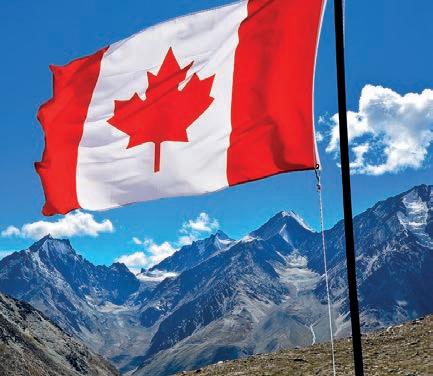
Chemostrat Canada Ltd in association with Belloy Petroleum Consulting Ltd can provide fast turnaround elemental, mineralogical, magnetics and TOC data in the lab, in the corestore or at wellsite for geosteering, correlation, reservoir quality and completion optimisation.

At GeoConvention: FOCUS 2014 we recently showcased our portable and wellsite solutions, demonstrating how clients can benefit from the combined strength of Chemostrat’s proven analytical and interpretative skills and Belloy’s 35 years of wellsite expertise in Canada.
Chemostrat/Belloy - Taking science to the field
In association with

Chemostrat Canada Ltd.
Sun Life Plaza West Tower, 144-4 Avenue SW, Suite 1600, Calgary, Alberta, T2P 3N4
t 403-463-8188
e CAoffice@chemostrat.com
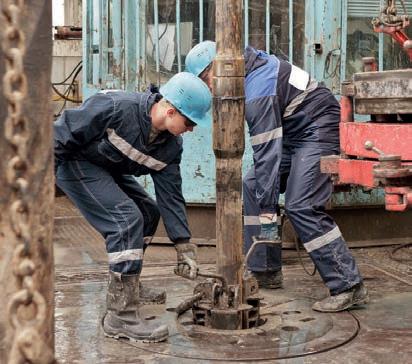


Belloy Petroleum Consulting Ltd.
102, 902 - 9th Avenue SE Calgary, Alberta, T2G 0S4
t 403-237-8700
e contact@belloy.ca


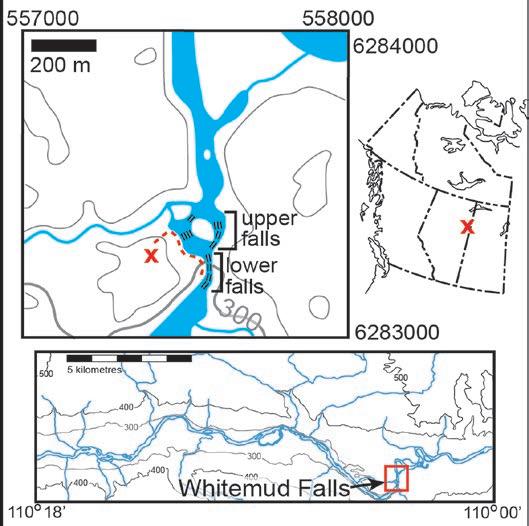


Trailhead: Before your trip, gain permission from Alberta Parks and Whitemud Falls Wildland Provincial Park to land a helicopter in Whitemud Falls Recreation Area. Land to the flat, open camping area. Walk south or east to the trail, and follow the trail as it winds northeast and then south around the margin of the cliff along the river to the falls. At the lower falls, the cliff becomes a fairly easy scramble to the base of the lower falls, including a short traverse through an arch of the Keg River dolostone. Note: when visiting in late summer to early autumn, “normal” river levels on the Clearwater River are sufficiently low to observe the features described herein. Higher water levels may preclude the observation of the Keg RiverLa Loche contact.
Distance: Approximately 1 km.
Elevation Loss: Approximately 15 m from the top of the cliff to the river’s edge at the base of the falls.
The Keg River Formation outcrop at Whitemud Falls on the Clearwater River is a good example of “typical” Keg River reef and inter-reef facies, as well as vuggy porosity after allochem dissolution, paleokarst, and Devonian-age marine flooding of an exposed Precambrian topographic high.
At the lower falls, the Keg River Formation sits directly on top of the granite wash of the La Loche Formation, and lacks the intervening argillaceous dolostone and siltstone of the Contact Rapids Formation. At this locality, the Contact Rapids Formation was never deposited; rather, the coarse sand of the La Loche Formation presumably sits directly on a topographic high in the Precambrian basement (unexposed). Because granite wash sediments appear in the surrounding carbonate, Keg River sedimentation commenced and the carbonate platform existed for some length of time before the topographic high was flooded.
The locality also includes several episodes of paleokarst. The oldest is associated with the topographic high and the La Loche granite wash. Adjacent paleo-crevices contain well-cemented granite wash sand and granules as well as green clay. The cliff above records another episode of paleokarst in a laterally and vertically extensive, well-cemented breccia. Modern karstification is apparent in the arch and the flowstone found on its inner surfaces.

From base to top, the stratigraphy of the outcrop is:
La Loche Formation:
1. Dark grey, coarse to very coarse grained, rounded, moderately sorted lithic sandstone with occasional granules and pebbles. The thickness of the La Loche Formation is unknown.
Keg River Formation:
2. At the base of the outcrop, above the La Loche Formation: 75 cm, medium grey, fine to medium crystalline, cherty, dolomitized lime mudstone containing solution vugs up to 2 cm in diameter. The chert is finely crystalline and dispersed in the dolostone; its presence becomes apparent in the sparks and odour while hammering the outcrop. A similar lithology also occurs in the Keg River Formation below the exposed La Loche Formation.
3. 565 cm of the “reef facies:” massive, vuggy, tabular-bedded in part, fine to medium crystalline, stromatoporoid-rich, dolomitized rudstone. Stromatoporoids are bulbous to massive. In-situ corals and stromatoporoids occur along an exposed bedding plane about 265 cm above the base of the unit.
4. Retracing your steps upslope towards the arch is 200 cm of grey breccia and flowstone. Clasts are dolomitized lime mudstone.
5. Upslope of the arch is 600 cm of “off-reef facies:” massive, medium-crystalline, crinoid-rich, dolomitized floatstone. Crinoid columnals are bright white against the beige-weathered surface of the rock.
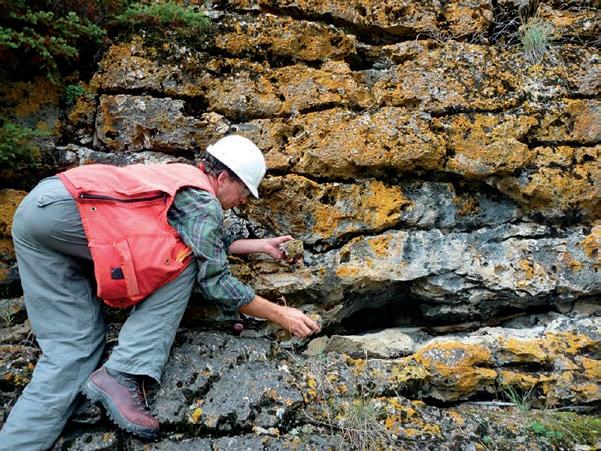

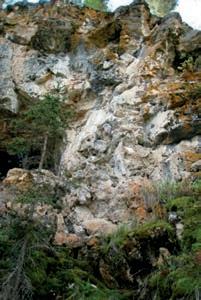

The Reservoir Committee welcomes contributions from our readership to this series. If you wish to offer a submission to Go Take a Hike on your favourite hike of geological interest, email the Reservoir at Emma.MacPherson@cspg.org for more information.

From the stratigraphy and observations about paleokarst, we interpreted the geological history of the locality (see Schneider et al., 2013):
1. Initiation of the Keg River Formation carbonate platform; some topographic highs of the Precambrian Formation, covered with granite wash sediments of the La Loche Formation, remained exposed (Figures 9-1 and 9-2).
2. Hiatus in carbonate sedimentation, subaerial exposure, and karstification when base level was nearly even with the topographic high and La Loche sediments. Granite wash, carbonate clasts, and crinoid columnals are washed into karsted crevices, and green clay formed during subaerial exposure is washed in or formed in-situ (Figure 9-3).
3. Sea level rises; initial intertidal stromatolites form on top of the granite wash (Figure 9-4). Continued relative sea-level rise results in the flooding of the topographic high and the formation and aggradation of a stromatoporoid-coral reef (Figure 9-5).
4. With further sea-level rise, the reef drowns and crinoid-rich, presumably deeper water, off-reef carbonate is deposited (Figure 9-6).
5. Following burial, diagenesis, dolomitization (Figures 9-7 and 9-8) and possibly

exhumation of the Keg River Formation, dissolution results in the collapse and accumulation of a breccia. This karst may or may not be related to the dissolution of the Prairie Evaporite Formation in the subsurface. Tilting of Devonian strata and subsequent erosion results in the Keg River Formation being uplifted close to the surface.
6. After Pleistocene glaciation, the Clearwater River downcut through the Keg River Formation. Resistance in the rock at this locality, perhaps from the existence of reefs, resulted in Whitemud Falls.
The take-away: The outcrop described herein at lower Whitemud Falls is a good example both of the reef and off-reef facies of the Keg River Formation and the influence of the Precambrian basement on deposition during this time. Furthermore, paleo- and modern karst at the outcrop indicate the important influence of karst processes during the history of the Keg River Formation.
Reference: Schneider, C.L. M. Grobe, and F.J. Hein, 2013, Outcrops of the La Loche, Contact Rapids, and Keg River Formations (Devonian) on the Clearwater River: Alberta (NTS 74D/9) and Saskatchewan (NTS 74C/12). ERCB/AGS Open File Report 2012-20, 43 p.

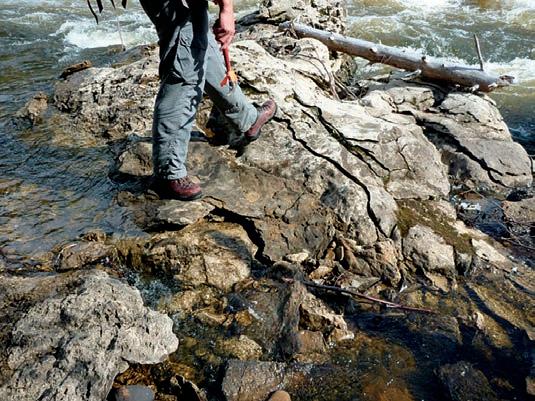




4 June 4--6th, 2014 |
Hot Reservoirs: The ultimate goal is to discover synergies between experienced industry in geothermal energy production and hydrocarbon industry with expertise in Alberta foreland geology, to spur economic opportunities for renewable energy development in Alberta.
Stressed Reservoirs: The goal of the forum is to have dynamic discussion about how knowledge of the stress state in subsurface reservoirs can help foster responsible development and optimize production.

Hot Reservoirs Speakers Announced!
Stephan Uhlig GeotecConsult, Germany
Geothermal success stories in foreland basins
Innovative geothermal technologies and perspectives
Warren Walsh
Ministry of Energy and Mines, British Columbia
Gerhard Pernecker Municipality Altheim, Austria
Stephan Hild Exorka GmbH, Germany
Jonathan Banks University of Alberta
Inga Moeck
Geothermal potential and synergies with hydrocarbons
University of Alberta & Technical University Munich
Craig Dunn Borealis Geopower Canada
Steve Grasby
Canadian Geological Survey
Grant Fergusson University of Saskatchewan
Kirk Osadetz
Canadian Geological Survey
Tibor Lenglin University of Alberta


The CSPG Link Award is awarded annually for the best oral presentation by a CSPG Member at one of the Society’s Technical Luncheons. Topics of the presentations must be either geological or of a related technical subject.
The recipient of the 2013 Link Award is Dr. Shahin Dashtgard for his November 22, 2013 presentation entitled, “What Petroleum Geologists Can Learn in Vancouver: Lessons from the Fraser River, BC.”
Shahin Dashtgard is an Associate Professor at Simon Fraser University. He specializes in the sedimentology and ichnology of marginal-marine and marine depositional environments and has spent much of the past seven years studying both modern environments and the Cretaceous strata of Western Canada. Most recently Shahin has focused his research on the tide-influenced lower reaches of the Fraser River, B.C. This data has been used to develop quantitative models for tidal-fluvial channels in the rock record. He was one of the founding members

of the Applied Research in Ichnology and Sedimentology (ARISE) Group at SFU, and
teaches courses in Advanced Sedimentology, Ichnology, Petroleum Geology, Sedimentary Petrology, and Paleontology.
Shahin earned his PhD from the University of Alberta in 2006 and his BSc from the same institution in 1998. Between and after degrees, he spent five years working as a petroleum geologist with the Alberta Geological Survey, Talisman Energy and Fletcher Challenge Energy Canada. In May 2012, Shahin received the James Lee Wilson Award from the SEPM for “excellence in sedimentary geology by a young scientist.” Outside of work, he enjoys coaching his daughter’s soccer team, playing hockey with his son, and fishing.
Work on Canadian Discovery and partners’ Duvernay Project is well underway. This study evaluates the Geomechanics, Hydrocarbon Systems and Geological Setting of the Devonian Duvernay Formation in the Kaybob to Willesden Green Area.
Results to date indicate:
» Variable lithology and a well-defined facies/ lithology dependent fracture fabric
» Stratigraphy shows a possible extension to the current play areas
» Geochemistry shows source rock maturity is strongly related to heat flow variations
A geomechanical evaluation, detailed geochemistry, hydrogeology and reservoir mapping will be completed prior to study delivery.
As specified in CSPG bylaws the Canadian Society of Petroleum Geologists Medal of Merit is awarded annually for the “best paper related to Canadian petroleum geology” published during the previous publication year, in this case for peer reviewed papers published in 2012. The medal is important recognition of excellence in Canadian petroleum geoscience research and writing and has been awarded since 1952. The paper chosen this year was written by Brett Miles, Ross Kukulski, M. Keegan Raines, John-Paul Zonneveld, Andrew Leier, and Stephen Hubbard and is entitled “A stratigraphic framework for Late Jurassic-Early Cretaceous gas-bearing strata (Monteith Formation) in the subsurface of northwest Alberta.” The paper was published in the March 2012 Bulletin of Canadian Petroleum Geology, v. 60, p. 3-36.
This paper describes how the correlation from the Monteith Formation type section in the British Columbia foothills into the subsurface was revised, allowing correlation of the Monteith into the study area in the Alberta Deep Basin. The internal stratigraphic architecture of this poorly constrained Late Jurassic to Early Cretaceous interval was developed, with the Monteith subdivided into 3 mappable units. The major facies and facies associations were described for each of the Monteith units using the available cores and the implications for tight gas reservoir potential were assessed. Upward transitions within the Monteith depositonal settings record a continuous progradation of a long-lived depositional system.
Isopach maps of the three Monteith units suggest that the foreland basin had initiated prior to Monteith Formation deposition and that deposition within the study area occurred on the cratonward side of the basin. Distribution of reservoir sandstones was strongly influenced by the basin physiography and tectonic uplifts and erosion within the Cordillera.
This work is an important contribution as it provides new data and interpretation of a poorly understood stratigraphic interval and will provide a framework for future tight gas development in the Monteith and Nikanassin formations. This paper illustrates the benefits which can come from detailed stratigraphic work in complex settings. In addition, the paper is very well written and
illustrated, and effectively integrates data from multiple sources.

Brett Miles received his B.Sc. from McMaster University and M.Sc. in Geology from the University of Calgary. His research was focused on the stratigraphy and sedimentology of the early foreland deposits of the WCSB. He is currently exploring for and characterizing various unconventional reservoirs with ConocoPhillips Canada.

Ross Kukulski graduated with his B.Sc. in 2009 and his Masters in 2012, both from the University of Calgary. He is currently working on the new ventures team at Chevron Canada. His interests include sedimentology and stratigraphy of clastics, and more recently carbonates.
Keegan Raines graduated with a B.Sc. in Earth Sciences from the University of Victoria in 2008. Before pursuing his Masters of Geology at the University of Calgary he gained experience with the BC government, the GSC, several research labs

at the University of Victoria, and Encana. Since 2011 he has been working with Imperial Oil on projects in the oil sands and Beaufort Sea.

Andrew Leier earned his Ph.D. from the University of Arizona in 2005 and became an Assistant Professor in the Department of Geoscience at the University of Calgary in 2007. His research focuses on sedimentation and tectonics and he has had projects in western North America, the Canadian Arctic, South America and Asia. He moved to the University of South Carolina in 2013 where he is an Associate Professor of Sedimentology in the Department of Earth and Ocean Sciences.
Steve Hubbard is an Associate Professor at the University of Calgary. He received his B.Sc. (1997) and M.Sc. (1999) degrees in Geology from the University of Alberta, and subsequently worked for two years at Shell Canada as a development geologist. He left the energy industry to pursue a Ph.D. in Geological and Environmental Sciences at Stanford University. Upon completion of his doctorate in 2006 he was hired by

the University of Calgary, and has taught courses in sedimentology, stratigraphy, petroleum geology, basin analysis and field geology. Steve’s research interests are in siliciclastic sedimentology and stratigraphy, from the bed- to basin- scale. While at the University of Calgary, he has led projects on Jurassic–Cretaceous Alberta foreland basin sedimentation, and outcropping deepwater strata of the Magallanes foreland basin, southern Chile. He has also studied fluvial systems, with a particular emphasis to better understand resource distribution in the Athabasca Oil Sands. He has published more than 40 peer-reviewed scientific articles and maintains an active research program supported by government and industry. He has supervised 16 graduate students at Calgary, as well as numerous undergraduate research projects. He served as Communications Director for the Canadian Society of Petroleum Geologists from 2010 to 2011 and has been an Associate Editor of the Journal of Sedimentary Research since 2009. He has recently been elected secretary-treasurer for the SEPM.
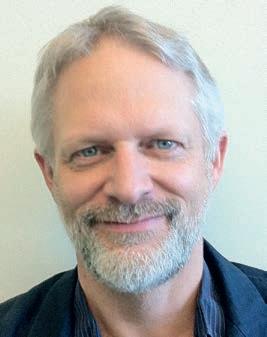
John-Paul Zonneveld is currently a Professor in the Department of Earth and Atmospheric Sciences at the University of Alberta, Edmonton. John-Paul is originally from Grimsby, Ontario and earned a B.Sc. from Calvin College in Grand Rapids,
Michigan, a M.Sc. in paleontology from Michigan State University and a Ph.D. in Geology from the University of Alberta. After completing his Ph.D. John-Paul was a post-doctoral researcher at the University of Calgary before joining the Geological Survey of Canada in Calgary as a research scientist. John-Paul left the GSC in 2007 for his present position where he teaches clastic sedimentology, petroleum basin analysis and field school. John-Paul has served as associate editor of both the Bulletin of Canadian Petroleum Geology and Palaios and is presently the senior co-editor of Palaios. He
research is currently focused on a number of areas including the Lower Triassic Montney Formation, the Middle Triassic Doig and Halfway formations and the Upper Triassic Charlie Lake Formation. John-Paul is also working on a number of neoichnological and sedimentological projects on the east and west coasts of North America to develop a better understanding of the physical and biogenic controls on deposition in finegrained depositional systems. He lives in St. Albert with his wife Shima and his daughters Zoe and Esme.




When time is money, Wellsite Geoscience is money well spent.
Whether you’re exploring a basin, producing a well or completing a shale play, time is money. That’s why Weatherford Laboratories brings a suite of formation evaluation technologies right to the wellsite. Utilizing mud gas and cuttings, these technologies provide detailed data on gas composition, organic richness, mineralogy and chemostratigraphy in near real time. As a result, operators now have an invaluable tool to assist with sweet spot identification, wellbore positioning, completion design and hydraulic fracturing. We call it Science At the Wellsite. You’ll call it money well spent.
SCIENCE AT THE WELLSITE ™
www.weatherfordlabs.com

The winner of the 2013 M.Sc. thesis award is Candace Brintnell . Her thesis entitled Architecture and Stratigraphy of the Lower Silurian Guelph Formation, Lockport Group, Southern Ontario and Michigan was supervised by Frank Brunton (Ontario Geological Survey), Drs. Jisuo Jin and Cameron J. Tsujita at Western University, London, Ontario. Financial support was
provided by a NSERC, Alexander Graham Bell Canada Graduate Scholarship (CGS-M) and an Ontario Graduate Scholarship in Science and Technology (OGSST) awarded to the author. The Ontario Geological Survey provided summer employment and funding for core library/sample preparation costs. Candace is now employed as a geologist at Husky Energy.
Candace’s thesis integrated outcrop data from the Niagara Escarpment in the vicinities of Guelph, Elora, Fergus, and the Bruce Peninsula with drill core and well log data from the Niagara Escarpment and westward in the onshore/offshore subsurface of southwestern Ontario and select cores from southeastern and northwestern Michigan, USA.
The Lockport Group, as recognized in southern Ontario and Michigan, is a succession of open- to restricted-marine carbonates of Wenlock age, comprising in ascending order: Gasport, Goat Island,
Eramosa, and Guelph formations. Despite having been studied for more than 150 years, efforts toward improving our understanding of the relative ages, lithofacies composition, and lateral facies transitions of the varied stratal units comprising the Lockport Group have proven challenging to stratigraphers / sedimentologists, oil/gas explorationists, and biostratigraphers. A few of the major factors that have hindered progress in this regard, include:
1) the paucity of exposures featuring the entire Lockport succession;
2) correlation difficulties related to lateral changes in lithology within the stacked dolostones of the Lockport Group due to short-lived tectophases and associated sea-level fluctuations, and subtle disconformities within similar grainstone packages;
3) diagenetic alteration and syn- & post-depositional karst processes and
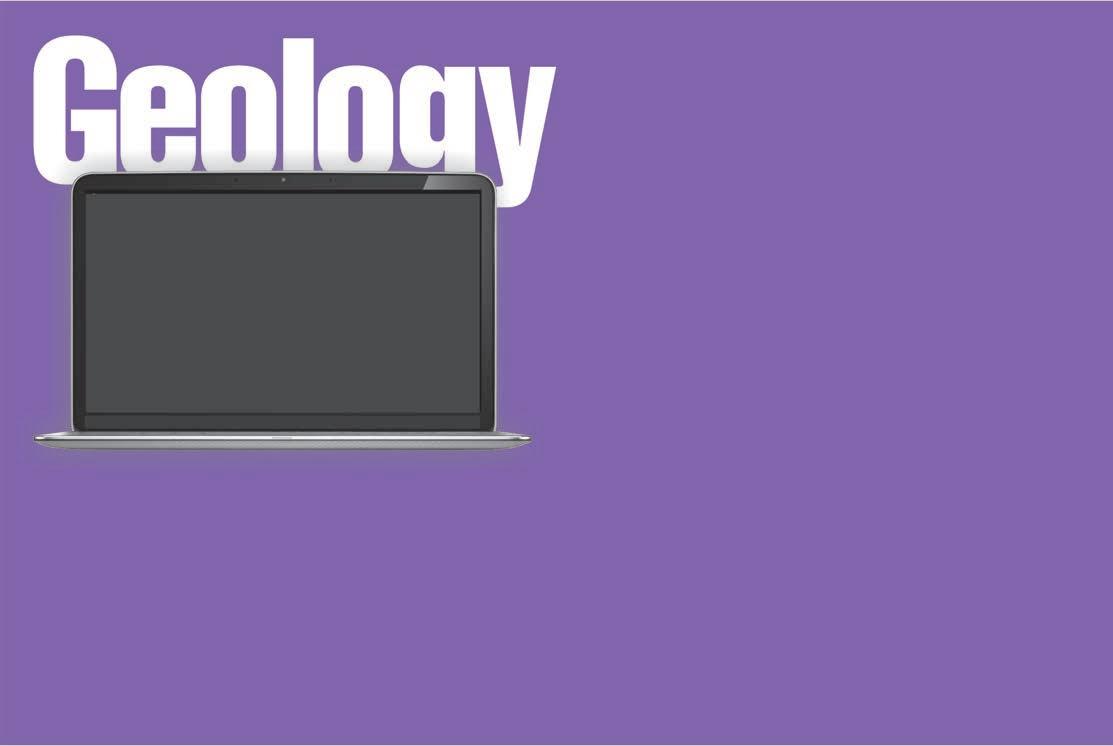


Figure 1: Depositional interpretation of the Eramosa and Guelph carbonate ramp of study area showing well localities of Lockport Group cores. The Eramosa and Guelph carbonates were deposited within an easterly dipping carbonate ramp during Early Wenlock. Oil & gas wells are indicated by red dots; stratigraphic test wells by purple dots; key outcrops or quarries by black triangles.
subsequent basinal fluid overprinting; and
4) nomenclatural confusion between subsurface and outcrop geologic studies.
The purpose of the project was to provide the first comprehensive regional stratigraphic perspective of the Guelph
Formation and its relationships to both the underlying Lockport Group and overlying Salina Group strata. The main conclusions of her project are as follows:
1) Confirmation that the Guelph Formation can be divided into two members (Lower and Upper members), each containing distinctive facies that
collectively contribute to a predictable architectural theme on a regional scale.
2) The more open-marine Guelph facies with minimal subaerial exposure and paleokarst occur in the eastern portion of the outcrop belt (E Michigan and NW Appalachian Foreland Basins). The most restricted marine strata, with multiple subaerial exposure episodes and paleokarstified intervals that extend downward into the underlying Goat Island Formation, occur in the central to western portions of what has been inferred to be the Michigan Basin.
3) Much of what has been called Guelph Formation in the central and northwestern parts of the Michigan Basin actually comprise stacked carbonates of older Lockport Group strata (Goat Island Fm). Also, where the Guelph Formation is present it is extensively karstified (breccias and subtle dissolution fabrics at older and therefore deeper sequence boundaries).
4) Detailed outcrop and core studies reveal that the widely adopted ‘pinnacle reef model’ inferred from previous investigations of the Guelph Formation are incorrect. More specifically, the recognition that the stacked dolostones that have been called Guelph Formation largely comprise older Goat Island and Gasport lithofacies in the central and northwestern parts of the Michigan
(Continued on page 30...)

2: Depositional model showing regional Lockport Group stratal relationships and post-Guelph erosional remnant features. Representing subaerial exposure, the onset of Salina Group deposition accompanied the drying out of the western part of the carbonate ramp, although shallow waters may have persisted in the east where penetrative karst is absent to minor in the uppermost Guelph Formation. Guelph strata was karstified and dissolved in a warm-wet climate and associated groundwater flow. Extensive karstification over an extended time (~1-2Ma) created a paleokarst basin with erosional cuestas of weathered Lockport Group strata. The resultant karst towers attained heights up to 150 m.
RIGSAT Communications
Apache Canada Ltd.
Advanced Flow Technologies
Crescent Point Energy
Enviro-Tech Surveys Ltd
EV Cam Canada Inc.
Gran Tierra Energy Inc.
Serpa Petroleum Consulting Ltd.
Exova Canada Inc
Sigma Explorations
Pason System
Pulse Seismic Inc
Shea Nerland Calnan LLP
SAExploration
Core Laboratories
Cabra Consulting Ltd.
Compass Directional Services
Cougar Consultants, Inc.
Canacol Energy Ltd.
Fekete
Paramount Resources
Sproule International Limited
Statoil Canada Ltd.
EDGE Technologies
Spectrum
BDO Canada LLP
Birchcliff Energy Ltd.
Cabra Enterprises Ltd.
Datalog Technology Inc.
GeoSpace Technologies
Knowledge Reservoir
Sproule Associates Limited
Geotir
Glacier Exploration Surveys
Matrix Solutions Inc.
McDaniel & Associates Consultants Ltd.
National Oilwell Varco
GeoChemTech Inc.
Cossack Land Services Ltd.
EPI Group
FMQ Southern Exploration
Matrix Geoservices Ltd.
Maxam Seismic Explosives
Petrel Robertson Consulting Ltd.
Statcom Ltd.
Trident Exploration Corp.
Sourcex
Caracal Energy Inc.
Regent Resources
Bankers Petroleum Ltd.
BJV Exploration Partnership
Nickpoint Environmental Services
SOCO International
3e Royalties
Bengal Energy
Bounty Developments Ltd.
Brasoil Corp.
Bukit Energy
Central European Petroleum Ltd
DualEx Energy International
Franconia Geoscience
Korean National Oil Company
Long Reach Resources Ltd.
Lorne LeClerc & Associates
Madison Petrogas Ltd.
Martin Wittstrom
Petroamerica
Serinus Energy
Sherritt International Corporation
Skyhawk Exploration
Tretio Exploration Ltd.
Basin; and that the lithofacies are both variably karstified and non-reefal and are not associated with slope deposit lithofacies, argues against such a model. Rather, the pinnacle-like topography, reflected by extreme thickness variations of the Lockport Group strata (on order of 100 m and extending for 0.5 to a number of kms in area) and the penetratively karstified basal Salina Group and Guelph Formation strata appear to represent erosional remnants rather than biogenically-contructed edifices.
5) These findings lead us to re-interpret the depositional history of the Lockport Group succession in the Michigan Basin in the following scenario: there was no central basin during Wenlock time and the regional variations in depositional and post-depositional fabrics of the Lockport Group, in particular for the Eramosa and Guelph formations, suggest deposition within an easterly dipping carbonate ramp during the Wenlock.
6) The Guelph Formation was subjected to regional erosion/karstification in
late and post-Guelph time that is reflected in extensive brecciation of the overlying basal Salina Group strata (A0, A1 and A2 facies). The proximal juxtaposition of younger Salina Group strata enveloping Lockport Group strata (Guelph through Gasport facies) in the subsurface of Michigan Basin is due to the regional development of karst towers within the more easily erodible, restricted marine facies of the Guelph and Eramosa carbonates. The grainstone/wackestone well indurated carbonates of the Goat Island and Gasport formations form the foundational cores of these erosional remnant structures. Therefore the paleotopographic relief of the so-called Guelph, or more accurately the upper Lockport Group, rimmed shelf Michigan Basin ‘bullseye’ reflects the remnants of a regionally extensive paleokarst basin. As such, the paleotopographic low of the upper Lockport Group in central Michigan is an erosional depression and not a deeper water depositional basin feature with seaway outlets and mythical rimmed pinnacle reefs.
The CSPG Corporate Relations Committee is keenly interested in fostering relationships with current and potential Corporate Partners. You may wonder, “What is a Corporate Partner? The CSPG does not have corporate members.” A Corporate Partner is a corporation or organisation that participates in the geoscience community and partners with the CSPG to mutual benefit. Some of the many things that Corporate Partners do include: encouraging employees to volunteer and provide geoscience mentorship; releasing information for publication; encouraging their geoscientists to take CSPG courses and activities for professional development; and sponsoring CSPG events that they see as important. Through their participation, CSPG members and their organisations see benefit through expanding awareness of new developments, strengthening their network within the geoscience community, augmenting their sense of pride in the geoscience community and gaining exposure to and collaborating with other members. Additionally, while not all companies wish
(...Continued from page 7)
public recognition for their contributions, the Corporate Sponsorship Program is designed to recognise the important financial sponsorship of the CSPG and its activities that many companies choose to make.
If you are a leader with Geoscientists in your company, the CSPG Corporate Relations Committee would like to hear from you! We can describe the benefits of participating as a Corporate Partner and benefits of membership for your Geoscientists. We look forward to hearing your thoughts. What do you like that the CSPG is currently doing? What additional services or activities would you would like to see from the CSPG? How could the CSPG’s activities support the goals of your organization? And in what form could you see your company supporting the CSPG? You can contact us at CorporateRelations@cspg.org.
www.apega.ca
The Summit Awards® honour and recognize the contributions Members make to the geoscience and engineering professions and to society. Our award recipients are saluted for their contributions to a better future for Alberta through the innovative use of science and technology and for their commitment to their communities. This year’s recipients were presented their awards by thenPresident Colin Yeo, P.Geo., FGC, FEC (Hon.), at the Summit Awards gala on April 24, 2014.
Congratulations!
Satinder Chopra, P.Geoph., FGC
The Frank Spragins Technical Award
In recognition of integrity and expertise and for outstanding accomplishments in fields related to the professions
Satinder Chopra, P.Geoph., is recognized in the global geophysical community as a leader for using his knowledge to calculate, evaluate and model underground pockets of tapped and untapped resources.
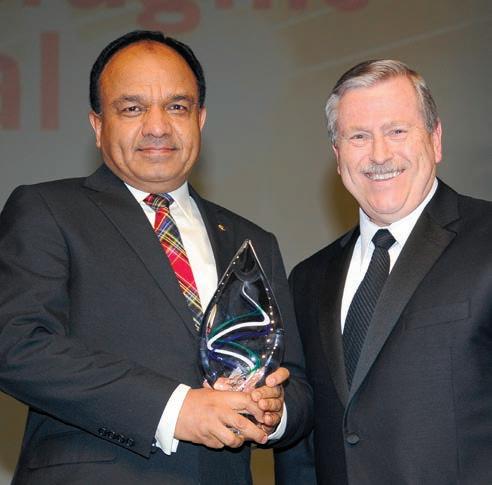
David Pattison, P.Geol., PhD
The Excellence in Education Award
In recognition of exemplary contributions to teaching and learning
David Pattison, P.Geol., is the Associate Head of the Department of Geoscience at the University of Calgary and has taken a lead role in redesigning and modernizing the geoscience curriculum.





